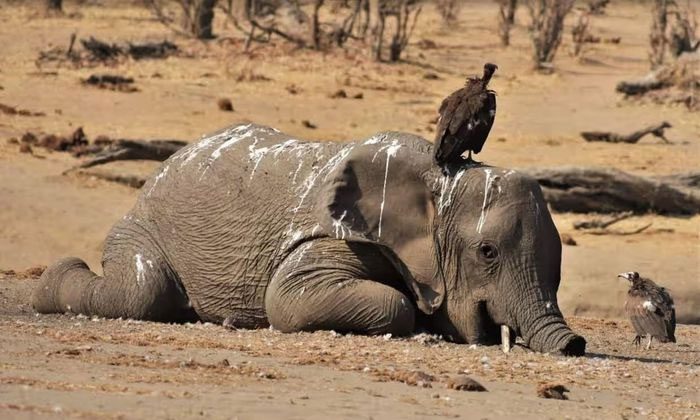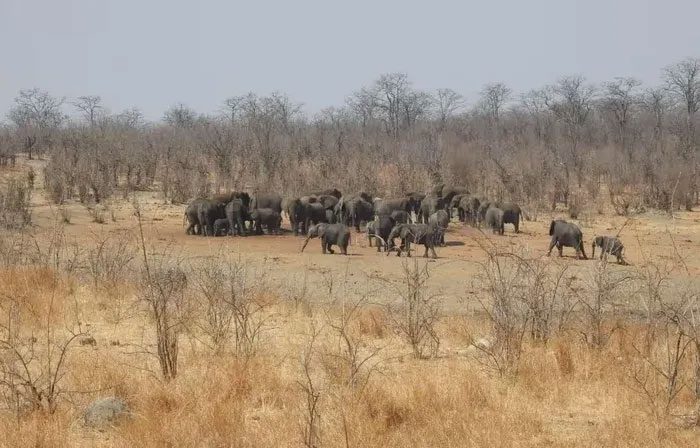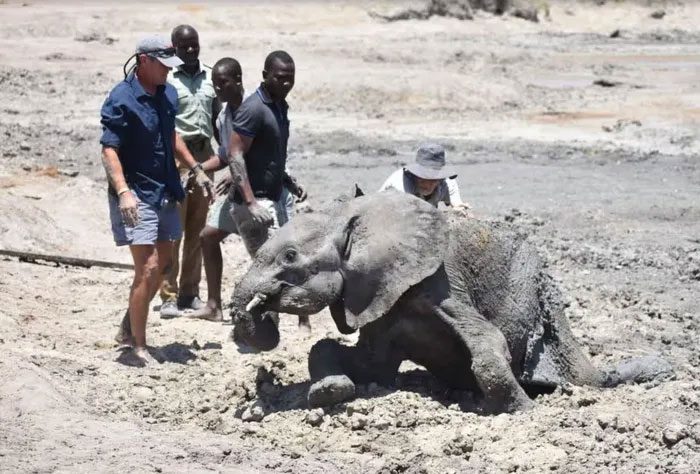Drought in Hwange National Park (Zimbabwe) is a major concern, and wildlife experts fear that climate change may make this phenomenon a norm.
At least 160 elephants have died due to drought in Zimbabwe, and the hot, dry weather may continue, raising conservationists’ concerns that this number could increase, according to The Guardian.
Most died 50-100 meters from water sources

One of the 160 elephants that died in late 2023 at Hwange National Park in Zimbabwe due to prolonged drought in the area. (Photo: Bhejane Trust).
The aforementioned elephant deaths were recorded from August to December 2023 in the 14,651 km2 Hwange National Park, home to elephants, buffaloes, lions, leopards, giraffes, and other endangered species.
At least 6 other elephants were recently discovered dead outside the park, possibly related to poaching.
The Zimbabwe Wildlife and Parks Authority (Zimparks) confirmed the deaths of the elephants in the park, attributing the cause to drought.
Mr. Tinashe Farawo, spokesperson for Zimparks, stated on January 16: “We have conducted inspections, and preliminary results indicate that the elephants died of starvation. Most of them were found 50-100 meters from water sources.”
According to the park officials, most of the deceased elephants were young, old, or weak.
The prolonged dry weather is wreaking havoc across Southern Africa. Mr. Trevor Lane, co-founder and head of the Bhejane Trust conservation group, noted that in 2023, there was no rainfall in Hwange Park from February to November.
“Poor nutrition, rising temperatures, and lack of water are having a significant impact, and this situation may continue into 2024,” Mr. Lane stated.
The National Oceanic and Atmospheric Administration (NOAA) predicts that the El Niño weather phenomenon will hit hard from October 2023 to March this year, resulting in hot, dry weather with little rainfall.
The United Nations Office for the Coordination of Humanitarian Affairs indicated in a November 2023 update that this could lead to “delayed rains and prolonged dry spells,” potentially causing drought in Zimbabwe.
The agency reported that by the end of 2023, “most of Zimbabwe received less than 50% of the seasonal cumulative rainfall compared to the long-term average.”
Conservation groups in Hwange are urgently drilling more wells and installing solar-powered systems to extend water pumping times to meet the anticipated pressure during the hot season starting in August.
Mr. Lane said: “We know we may face El Niño and significant drought in 2024. We will see what we can do to mitigate this, but it will be a life-and-death situation, and if another drought occurs, we will have to go through this again.”
Drought has previously caused mass elephant deaths in Zimbabwe – in 2019, over 200 elephants died in just over two months due to lack of water.
Veterinarians and conservationists in Hwange reported that initially, the deceased elephants were concentrated around one of the park’s most popular water sources. Subsequently, the area of “death” spread.
Another conservationist revealed that during a count in September 2023, experts recorded over 1,800 elephants trying to drink from a single water source.

Elephants gather around a water outlet at Tshompani Pan in Hwange National Park in November 2023. (Photo: Bhejane Trust).
A conservationist, who requested to remain anonymous, shared: “It’s horrifying to witness orphaned calves waiting for death, and it’s dreadful to drive around and see and smell the corpses of elephants.”
“What we need to worry about is the potential for climate change to make wildlife deaths due to drought this year a norm,” the individual added.
Threats
As drought intensifies, the resurgence of poaching also threatens Zimbabwean elephants and other wildlife. The latest six reported elephant deaths in January were in Gwayi, an area just outside Hwange National Park. Conservation and environmental advocacy groups suggest that poaching may be the cause.
Zimparks confirmed these six elephant deaths and stated that veterinarians are still investigating the cause. Environmental groups revealed that elephant tusks had been removed, indicating poaching activity.
The Zimbabwe Environmental Law Association stated in a statement that “the poaching incident in Gwayi occurs against the backdrop of increasing illegal wildlife trade and wildlife crime.”

In desperation, animals attempt to drink muddy water, and the smaller ones get stuck. Staff at Hwange rescued this baby elephant. (Photo: Bhejane Trust).
Mr. Lane affirmed: “The increase in bushmeat poaching is alarming, and based on our experience and that of other organizations, it may be due to the economic situation” in Zimbabwe. He added: “People are desperate and turning to poaching wildlife.”
In December 2023, as the hunger season approached, USAID’s Famine Early Warning Systems Network reported that “food reserves of poor households have been depleted” and the country’s food security is at “stress” or “crisis” levels.
Nick Long, who oversees anti-poaching programs and patrols in Hwange, also confirmed “the increase in bushmeat poaching nationwide,” particularly from November to December 2023.
“Bushmeat poaching is a significant concern in the Victoria Falls area. Our sister organization, the Victoria Falls Anti-Poaching Unit, faced a tough December combating poaching everywhere,” he stated.


















































